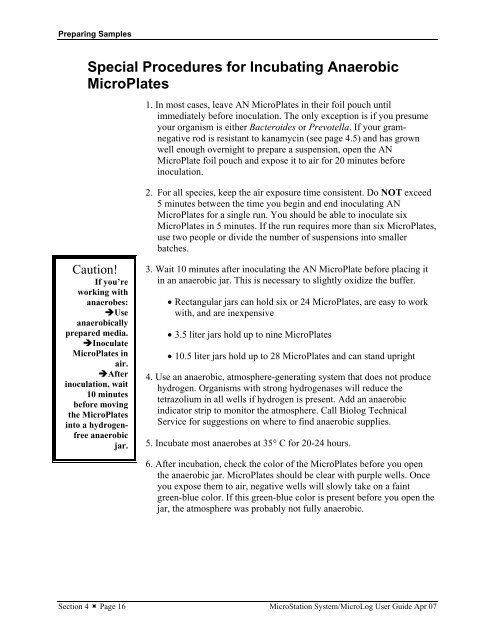MicroStation System, MicroLog Version 4.2 - DTU Systems Biology ...
MicroStation System, MicroLog Version 4.2 - DTU Systems Biology ...
MicroStation System, MicroLog Version 4.2 - DTU Systems Biology ...
You also want an ePaper? Increase the reach of your titles
YUMPU automatically turns print PDFs into web optimized ePapers that Google loves.
Preparing Samples<br />
Special Procedures for Incubating Anaerobic<br />
MicroPlates<br />
Caution!<br />
If you’re<br />
working with<br />
anaerobes:<br />
�Use<br />
anaerobically<br />
prepared media.<br />
�Inoculate<br />
MicroPlates in<br />
air.<br />
�After<br />
inoculation, wait<br />
10 minutes<br />
before moving<br />
the MicroPlates<br />
into a hydrogenfree<br />
anaerobic<br />
jar.<br />
1. In most cases, leave AN MicroPlates in their foil pouch until<br />
immediately before inoculation. The only exception is if you presume<br />
your organism is either Bacteroides or Prevotella. If your gramnegative<br />
rod is resistant to kanamycin (see page 4.5) and has grown<br />
well enough overnight to prepare a suspension, open the AN<br />
MicroPlate foil pouch and expose it to air for 20 minutes before<br />
inoculation.<br />
2. For all species, keep the air exposure time consistent. Do NOT exceed<br />
5 minutes between the time you begin and end inoculating AN<br />
MicroPlates for a single run. You should be able to inoculate six<br />
MicroPlates in 5 minutes. If the run requires more than six MicroPlates,<br />
use two people or divide the number of suspensions into smaller<br />
batches.<br />
3. Wait 10 minutes after inoculating the AN MicroPlate before placing it<br />
in an anaerobic jar. This is necessary to slightly oxidize the buffer.<br />
• Rectangular jars can hold six or 24 MicroPlates, are easy to work<br />
with, and are inexpensive<br />
• 3.5 liter jars hold up to nine MicroPlates<br />
• 10.5 liter jars hold up to 28 MicroPlates and can stand upright<br />
4. Use an anaerobic, atmosphere-generating system that does not produce<br />
hydrogen. Organisms with strong hydrogenases will reduce the<br />
tetrazolium in all wells if hydrogen is present. Add an anaerobic<br />
indicator strip to monitor the atmosphere. Call Biolog Technical<br />
Service for suggestions on where to find anaerobic supplies.<br />
5. Incubate most anaerobes at 35° C for 20-24 hours.<br />
6. After incubation, check the color of the MicroPlates before you open<br />
the anaerobic jar. MicroPlates should be clear with purple wells. Once<br />
you expose them to air, negative wells will slowly take on a faint<br />
green-blue color. If this green-blue color is present before you open the<br />
jar, the atmosphere was probably not fully anaerobic.<br />
Section 4 � Page 16 <strong>MicroStation</strong> <strong>System</strong>/<strong>MicroLog</strong> User Guide Apr 07


